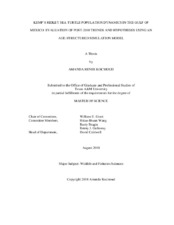| dc.contributor.advisor | Grant, William E | |
| dc.creator | Kocmoud, Amanda Renee | |
| dc.date.accessioned | 2019-01-18T15:25:30Z | |
| dc.date.available | 2020-08-01T06:37:59Z | |
| dc.date.created | 2018-08 | |
| dc.date.issued | 2018-08-03 | |
| dc.date.submitted | August 2018 | |
| dc.identifier.uri | https://hdl.handle.net/1969.1/174039 | |
| dc.description.abstract | Kemp’s ridley sea turtle (Lepidochelys kempii) is a critically-endangered species endemic to the Gulf of Mexico. Prior to 2010, based on nest counts at the primary nesting beach, the population appeared to be recovering. Since the lowest point in 1985, the population had exhibited an estimated annual growth rate of 19%. However, following a large mortality event between the 2009 and 2010 nesting seasons, population levels began to fluctuate. The present work describes development and use of an age-structured population simulation model to investigate plausibility of three hypothesized cause-effect relationships between the 2010 mortality event and subsequent population fluctuations.
The baseline model was parameterized based on published Kemp’s ridley life history data and calibrated by adjusting the natural mortality rate of post-hatchlings (nph) such that simulated annual rate of population increase (λ) was within 2% of the observed λ based on nest counts from 1985 to 2009. Sensitivity analysis indicated λ was most sensitive to changes in nph. The calibrated model was modified to incorporate each of the three hypothesized effects of the 2010 mortality event: (1) a single year “pulse” effect increasing Kemp’s ridley mortality, (2) a multiple year “press” effect increasing Kemp’s ridley mortality, and (3) a density-dependent effect decreasing recruitment due to a lengthened remigration interval. Scenarios representing various versions of each of these hypotheses were simulated and tested based on four criteria which characterized the population fluctuations observed from 2010 to 2014.
None of the scenarios representing the “pulse” or “press” hypotheses satisfied all four hypothesis-testing criteria. Two scenarios representing the “density-dependent remigration” hypothesis satisfied all four criteria: (1) an exponential and (2) an inverse logistic relationship between remigration rate and number of reproductive individuals. Only the inverse logistic relationship was tentatively validated via comparison of population projections to an independent dataset consisting of nest counts at the primary nesting beach from 2015 to 2017. Population projections to 2035 using the inverse logistic version suggested down-listing criteria may be achieved as early as 2019. The model was the first of its kind to test these hypotheses and should prove useful to management professionals considering conservation strategies for Kemp’s ridley sea turtles. | en |
| dc.format.mimetype | application/pdf | |
| dc.language.iso | en | |
| dc.subject | Kemp's ridley sea turtle | en |
| dc.subject | population dynamics | en |
| dc.subject | remigration | en |
| dc.subject | simulation model | en |
| dc.subject | ecological modeling | en |
| dc.subject | pulse | en |
| dc.subject | press | en |
| dc.subject | density-dependent | en |
| dc.subject | 2010 mortality | en |
| dc.subject | oil spill | en |
| dc.subject | Deepwater Horizon | en |
| dc.title | Kemp's Ridley Sea Turtle Population Dynamics in the Gulf of Mexico: Evaluation of Post-2010 Trends and Hypotheses Using an Age-Structured Simulation Model | en |
| dc.type | Thesis | en |
| thesis.degree.department | Wildlife and Fisheries Sciences | en |
| thesis.degree.discipline | Wildlife and Fisheries Sciences | en |
| thesis.degree.grantor | Texas A & M University | en |
| thesis.degree.name | Master of Science | en |
| thesis.degree.level | Masters | en |
| dc.contributor.committeeMember | Wang, Hsiao-Hsuan | |
| dc.contributor.committeeMember | Feagin, Rusty | |
| dc.contributor.committeeMember | Gallaway, Benny J | |
| dc.type.material | text | en |
| dc.date.updated | 2019-01-18T15:25:31Z | |
| local.embargo.terms | 2020-08-01 | |
| local.etdauthor.orcid | 0000-0002-3728-5658 | |


